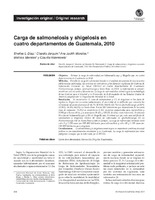Guía para la vigilancia de la enfermedad por el virus del Zika y sus complicaciones. Edición 2018
Guidelines for Surveillance of Zika Virus Disease and Its Complications. 2018 edition
Date
2018ISBN
978-92-75-12019-4 978-92-75-32019-8
Metadata
Show full item recordAbstract
[Purpose and Scope]. This document aims to provide guidance for the implementation of longer-term and sustainable ZIKV disease surveillance following the conclusion of the PHEIC. It provides overall guidance — albeit not exhaustive — on surveillance activities, primarily intended for countries expected to have ongoing vector borne transmission of ZIKV in the post-PHEIC phase and should be adapted by countries to their capabilities, epidemiological context, and health system’s characteristics. Based on available information, and to guide case reporting, a brief clinical description of the disease is included, encompassing its neurological manifestations and information on congenital ZIKV syndrome. Surveillance strategies are proposed, along with case definitions, and laboratory procedures for detection and diagnosis. While this document focuses primarily on ZIKV disease, it also proposes elements to integrate ZIKV surveillance with that of other arboviral and rash/febrile diseases, and addresses differential diagnosis in the laboratory. This proposal is to be implemented at the national level in each country, and, depending on the health system’s organization, should be adapted to the different spheres of the health system (local, regional, and national). As with other technical documents, these guidelines should be reviewed and updated as the understanding of the disease and its complications progress. [Finalidad y alcance]. El presente documento tiene por objeto orientar, a largo plazo, la puesta en marcha de la vigilancia sostenible de la enfermedad por el virus del Zika en la fase posterior a la ESPII. El documento proporciona orientación general, aunque no exhaustiva, sobre las actividades de vigilancia, y está destinado principalmente a los paises en los que se espera transmisión vectorial de ZIKV en la fase posterior a la ESPII; corresponderá a cada país adaptarla en función de su capacidad, contexto epidemiológico y características del sistema de salud. Se incluye también una breve descripción clínica de la enfermedad, sus manifestaciones neurológicas y el síndrome congénito por ZIKV, según la información disponible, con el objeto de guiar la sospecha clínica necesaria para la notificación de casos. También se proponen estrategias de vigilancia, definiciones de caso y procedimientos de detección y diagnóstico por laboratorio. Si bien la guía se concentra mayormente en el ZIKV, introduce elementos para integrar su vigilancia con la de otras arbovirosis y enfermedades febriles exantemáticas y aborda el diagnóstico diferencial en el laboratorio. Esta es una propuesta para poner en marcha en el ámbito nacional de cada país, que, según el modelo de organización, deberá ajustarse para las diferentes esferas del sistema de salud (local, regional/intermedio y nacional). Al igual que otros documentos técnicos, este deberá ser revisado y actualizado a medida que avanza el conocimiento sobre el tema.
Subject
Category of PAHO Strategic Plan 2014-2019
Citation
Pan American Health Organization. Guidelines for Surveillance of Zika Virus Disease and Its Complications.2018 edition. Washington, D.C.: PAHO; 2018. Available from: http://iris.paho.org/xmlui/handle/10665.2/49518 Organización Panamericana de la Salud. Guía para la vigilancia de la enfermedad por el virus del Zika y sus complicaciones. Washington, D.C.: OPS; 2018. Disponible en: http://iris.paho.org/xmlui/handle/10665.2/49518
Collections
Related items
Showing items related by title, author, creator and subject.
-
Saboyá-Díaz, Martha-Idalí; Castellanos, Luis Gerardo; Morice, Ana; Ade, Maria Paz; Rey-Benito, Gloria; Cooley, Gretchen M.; Scobie, Heather M.; Wiegand, Ryan E.; Coughlin, Melissa M.; Martin, Diana L. (2023)[ABSTRACT]. Objective. Systematize the experience and identify challenges and lessons learned in the implementation of an initiative for integrated serosurveillance of communicable diseases using a multiplex bead assay in ...
-
Zika virus outbreak in 19 English- and Dutch-speaking Caribbean countries and territories, 2015–2016 Francis, Lorraine; Hunte, Shelly-Ann; Valadere, Ann Marie; Polson-Edwards, Karen; Asin-Oostburg, Virginia; Hospedales, C. James (2018)[ABSTRACT]. Surveillance for Zika virus was enhanced in the English- and Dutch-speaking Caribbean following emergence of the virus in Brazil in May 2015. The first autochthonous case of Zika in the Caribbean was reported ...
-
Díaz, Sheilee L.; Jarquin, Claudia; Morales, Ana Judith; Morales, Melissa; Valenzuela, Claudia (2015)Objetivo. Estimar la carga de enfermedad por Salmonella spp. y Shigella spp. en cuatro departamentos de Guatemala en 2010. Métodos. Estudio de carga de enfermedad basado en el análisis documental de las encuestas poblacionales ...




